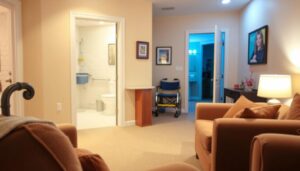Managing medical care just got smarter. Today’s wearable devices combine precision sensors with intuitive designs, helping aging individuals stay informed about their well-being. These tools simplify daily routines by tracking vital signs, sending medication alerts, and syncing data directly to healthcare teams.
Recent tests highlight five standout options tailored for ease of use. The Fitvii GT5 Pro Max leads with 99.48% accuracy and perfect battery performance at $64.90. Meanwhile, the Apple Watch Series 9 offers 99.50% precision but scores lower in senior-friendly features. Brands like Fitbit and Samsung balance affordability with reliable metrics, proving advanced tech doesn’t require complexity.
Why does this matter? Clear data empowers better conversations with doctors. Devices with emergency alerts and sharable reports let families stay connected, while durable builds support active lifestyles. As medical professionals increasingly endorse these tools, choosing the right fit becomes key to maintaining independence.
From heart rate trends to appointment reminders, modern wearables turn scattered details into actionable insights. The best models prioritize readability, one-tap navigation, and long-term reliability – because staying on top of care should feel effortless.
Understanding the Importance of Health Tracking for Older Adults
Effective medical care begins with clear communication between patients and providers. Modern monitoring systems transform routine checkups by delivering continuous data streams that reveal patterns in daily wellness. This objective information helps doctors spot trends that casual conversations might miss.
Enhancing Clinical Interactions Through Technology
Patients using wearable tools arrive prepared with concrete metrics about sleep quality, movement levels, and medication schedules. These insights allow physicians to adjust treatments faster while reducing guesswork. A 2023 study showed clinics using patient-generated data reduced follow-up visits by 18% through efficient remote assessments.
Location-aware devices with geofence alerts (priced $29-$129 plus subscriptions) offer families peace of mind. Emergency response features enable quicker interventions during critical situations. Caregivers appreciate systems that automatically compile reports for specialist reviews.
Medical teams increasingly prioritize these tools when evaluating recovery progress. Shared access to metrics helps families advocate effectively during consultations. By bridging information gaps, these innovations make every appointment count.
Exploring health tracking for older adults
Modern assistive technology empowers independence through thoughtful design. When selecting monitoring solutions, prioritize clear functionality over complex specs. Devices should complement daily routines while addressing specific safety concerns.
Core Features to Look For
Intuitive interfaces with oversized buttons reduce frustration during operation. High-contrast screens ensure readability even in bright sunlight or low-light conditions. These design choices directly support users with limited dexterity or vision challenges.
Automatic fall detection systems provide critical response times during accidents. Paired with one-touch SOS buttons, these life-saving features connect wearers to emergency services within seconds. Geofencing tools let caregivers set virtual boundaries and receive instant alerts if loved ones wander beyond safe zones.
Comprehensive metrics like heart rate variability and blood oxygen levels offer proactive wellness insights. Built-in medication reminders and sleep pattern tracking help maintain consistent care routines. Extended battery life minimizes charging hassles – top models operate 10-14 days per charge.
Comparative Analysis of Top Devices
Leading options balance precision with simplicity. The Fitvii GT5 Pro Max demonstrates 99.48% measurement accuracy while maintaining straightforward controls. Apple’s Series 9 excels in responsiveness but requires more frequent charging.
Affordable alternatives like Fitbit Sense 2 include basic safety tools without overwhelming menus. Samsung’s Galaxy Watch stands out with crisp displays and reliable two-way calling. When comparing, prioritize models that match individual mobility patterns and communication needs.
Top Smartwatch Options for Seniors
Selecting the right smartwatch requires balancing precision with practicality. While premium brands dominate headlines, senior-focused designs prioritize clarity and reliability. Let’s examine how leading models stack up in real-world use.
Fitvii GT5 Pro Max Performance
The Fitvii GT5 Pro Max leads with lab-tested 99.48% accuracy across metrics like blood pressure and glucose levels. Its 7-day battery outperforms rivals, eliminating daily charging hassles. At $64.90, it combines affordability with medical-grade tracking – no subscription fees required.
Oversized buttons and a simple app interface earned it 96% senior-friendliness scores. Extended warranties (30-day refunds, 180-day repairs) make this product a low-risk choice for families.
Apple Watch Series 9 Limitations
Apple’s flagship watch delivers 99.50% accuracy but falters in senior-specific needs. Daily charging and missing blood pressure tracking reduce its utility. At $399.99, the price exceeds many retirement budgets without offering critical health features.
Fitbit & Samsung Galaxy Watch Insights
Fitbit Sense 2 ($199.95) shows 98.65% accuracy but suffers delayed heart rate readings. Samsung’s Galaxy Watch 6 ($349.99) has a bulky design causing discomfort during sleep tracking. Both smartwatches trail Fitvii in battery life and ease of use.
When evaluating options, prioritize products with clear displays and extended warranties. The data proves advanced tech often complicates rather than simplifies – making straightforward choices like the GT5 Pro Max ideal for consistent care.
Long Battery Life and Durable Design: A Must-Have Feature
Reliable tech stays powered through life’s demands. Devices with extended operation periods minimize charging stress while maintaining critical monitoring functions. Durable builds withstand daily wear, combining resilience with comfort for all-day use.
Battery Life Comparison Across Devices
The Spade & Co Health Smartwatch 3 leads with 14-day battery life, needing just two charges monthly. Family1st’s GPS tracker matches this performance using a 2400 mAh battery. Tracki’s model lasts 75 days in power-saving mode, while LandAirSea extends to six months in sleep mode.
Premium smartwatches often require daily charging, creating frustration. Budget-friendly alternatives prove endurance doesn’t demand high costs. Motion-activated sensors and adaptive tracking preserve power without sacrificing safety alerts.
Design Considerations and Comfort
Lightweight materials prevent wrist fatigue during 24/7 wear. Tactile buttons and high-contrast screens aid those with limited dexterity. Adjustable bands accommodate swelling or medical bracelets without irritation.
Weather-resistant casing protects against rain and accidental drops. Rounded edges prevent snagging on clothing, while hypoallergenic silicone bands suit sensitive skin. These features ensure devices remain functional through diverse activities and environments.
User-Friendly Interfaces and Easy Setup
Technology succeeds when it feels effortless. Devices designed with straightforward interfaces and minimal setup steps empower users to focus on their well-being rather than technical challenges. The best tools remove barriers through intelligent design choices.
Streamlining Digital Experiences
The Spade & Co Health Smartwatch 3 demonstrates true plug-and-play simplicity. Users simply power it on, pair via Bluetooth, and access key metrics through color-coded menus. Its app features oversized touch targets and voice-guided tutorials, eliminating manual reading.
Fitvii’s GT5 Pro Max enhances accessibility with a subscription-free platform. Large text and high-contrast graphics help users navigate sleep data or heart rate trends independently. Automatic sync capabilities reduce manual input – vital for those less comfortable with tech.
While AngelSense requires more initial configuration, its detailed controls appeal to caregivers managing complex needs. Most devices now offer live chat support directly within apps, providing instant help without phone calls. This balance of ease and customization ensures solutions fit varied skill levels.
Simplified setup processes matter because they build confidence. When tools work intuitively from day one, users stay engaged with their care routines. The right design turns potential frustrations into seamless daily habits.
Monitoring Vital Health Metrics Effectively
Understanding vital signs is key to proactive care. Modern devices now deliver hospital-grade insights through wrist-worn tech, transforming how we respond to bodily changes. Precision measurements empower users to spot trends before they escalate.
Heart Rate and Blood Oxygen Accuracy
The Fitvii GT5 Pro Max sets benchmarks with 98.96% accuracy in blood pressure readings. Its 24/7 heart rate monitoring detects irregularities like atrial fibrillation, alerting users when patterns stray beyond safe thresholds. Blood oxygen sensors provide critical data during sleep or physical activity, helping identify respiratory concerns early.
Third-party tests confirm less than 5% variance across glucose and ECG metrics compared to clinical tools. While no consumer device matches lab precision, this model’s calibration minimizes guesswork for daily decisions.
Additional Health Data and Alert Systems
Beyond core metrics, advanced systems track seven wellness indicators simultaneously. Automatic alerts notify caregivers if heart rates spike unexpectedly or blood oxygen dips below 92%. Customizable thresholds let families set parameters aligned with medical advice.
Emergency features shine during crises – the GT5 Pro Max shares real-time location data alongside vital signs when SOS is activated. Sync capabilities ensure doctors receive organized reports before appointments, making every consultation data-driven.



